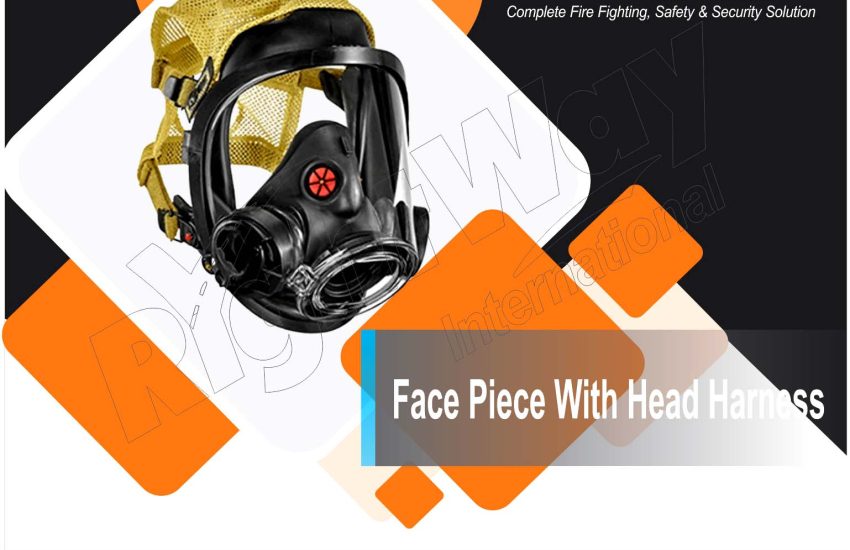Face-Piece with Head Harness is a vital element of respiratory protection systems, including masks and respirators. It ensures a secure, sealed, and comfortable fit, allowing users to breathe safely in environments containing harmful airborne substances. Whether in industrial, healthcare, or emergency response settings, this component plays a central role in safeguarding health and performance.
1. Purpose and Importance of Face-Piece with Head Harness
The primary goal of the facepiece and head harness system is to form a reliable seal against the user’s face while holding the respirator or mask in place. This seal is essential for preventing airborne contaminants—such as dust, gases, fumes, and pathogens—from bypassing filtration systems.
In addition to ensuring protection, the head harness contributes to long-term wearability and comfort, especially in demanding environments where extended use is common.
2. Key Components of the System
The system consists of two main parts: the facepiece and the head harness. Each serves a distinct and essential role.
Facepiece
This part covers the user’s nose, mouth, and often eyes. It is typically constructed from flexible and durable materials like silicone, rubber, or thermoplastic elastomer (TPE).
Key features include:
- Mask Body: The main structure that forms the seal against the face.
- Filters or Cartridges: These filter out contaminants and may be integrated or replaceable.
- Inhalation Valve: Allows clean air to enter the mask during inhalation.
- Exhalation Valve: Vents exhaled air, reducing internal heat, moisture, and carbon dioxide buildup.
Head Harness
The head harness secures the facepiece and ensures that it remains properly positioned during use.
Typical components include:
- Adjustable Straps: Made from elastic or nylon, these allow a tight yet comfortable fit.
- Over-the-head straps distribute weight across the crown.
- Neck straps secure the lower portion of the facepiece.
- Buckles or Clips: Enable quick adjustments and firm fastening.
- Padding: Often added for comfort and to minimize pressure on the head and face.
Together, these elements ensure that the facepiece stays sealed and steady, even during intense physical activity.
3. Types of Facepieces with Head Harnesses
There are several designs to accommodate different protection needs and working environments:
Full-Face Respirators
These cover the entire face, including the eyes, offering maximum protection from respiratory and ocular hazards. They are commonly used in chemical plants, firefighting, and toxic spill response.
Half-Face Respirators
Covering only the nose and mouth, these respirators are lighter and less restrictive, ideal for tasks where eye protection is provided separately.
PAPR (Powered Air-Purifying Respirators)
This type uses a battery-powered fan to draw air through filters. The facepiece typically integrates with a head harness, while the fan unit is belt-mounted or backpack-mounted. It is excellent for high-exposure tasks that require low breathing resistance.
4. Common Applications
Facepieces with head harnesses are found across a wide range of sectors:
- Industrial Work: Protects employees in factories and construction from dust, chemical vapors, and fumes.
- Emergency Response: Offers vital protection in firefighting, disaster relief, and hazardous materials response.
- Healthcare Settings: Used by medical staff to prevent exposure to airborne pathogens, especially during procedures involving infection risk.
- Construction: Shields workers from dust, asbestos fibers, and particulate matter on job sites.
In all cases, proper use is essential for ensuring effective protection.
5. Maintenance and Care
To maintain optimal performance and prolong the life of the facepiece and head harness:
- Perform Regular Inspections: Check for tears, wear, or contamination. Ensure valves function correctly and straps remain elastic and intact.
- Clean After Each Use: Follow manufacturer instructions. Use mild, non-abrasive cleaning agents and avoid harsh chemicals that can degrade materials.
- Store Properly: Keep the equipment in a dry, cool area, away from direct sunlight or extreme temperatures.
- Replace Components Promptly: Filters, cartridges, and any worn parts should be replaced according to usage and manufacturer guidelines.
Regular upkeep ensures that users remain protected and comfortable during every use.
6. Safety Considerations
To guarantee safety, users must follow best practices:
- Ensure a Secure Fit: Always perform a fit check before entering a contaminated area. Any air leakage compromises the protective seal.
- Adjust Properly: Tighten straps evenly to maintain comfort and prevent slippage. Avoid over-tightening, which can cause pressure points or headaches.
- Provide Training: Educate users on correct donning, adjustment, cleaning, and troubleshooting techniques.
These practices help prevent failures that could result in harmful exposure.
7. Regulatory Compliance
To ensure effectiveness and reliability, facepieces and harness systems must meet standards set by key safety authorities:
- OSHA (Occupational Safety and Health Administration)
- NIOSH (National Institute for Occupational Safety and Health)
- CEN (European Committee for Standardization)
- ANSI (American National Standards Institute)
Compliance guarantees that the equipment has passed rigorous testing for fit, material quality, and protection level.
Conclusion
The facepiece with head harness is not just a component—it’s a cornerstone of any effective respiratory protection system. By ensuring a tight, comfortable seal, it protects users from serious health hazards. Through proper selection, adjustment, care, and training, users can maximize both comfort and safety. When correctly maintained, this system provides reliable, life-saving protection in even the most challenging environments.


